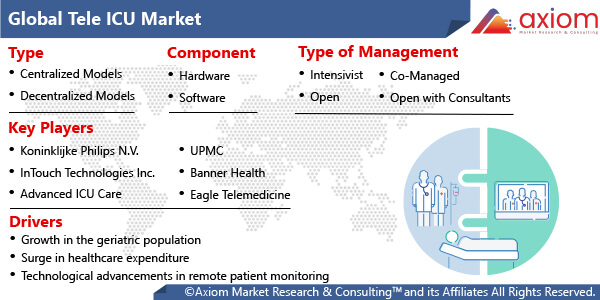COVID-19 Impact Analysis on Global Tele ICU Market
The exclusive COVID-19 impact analysis report by Axiom MRC provides a 360 degree analysis of micro and macro-economic factors on the global Tele ICU market. In addition, complete analysis of changes on the global Tele ICU market expenditure, economic and international policies on supply and demand side. The report also studies the impact of pandemic on global economies, international trade, business investments, GDP and marketing strategies of key players present in the market.
Market Overview- Global Tele ICU Market
Market Drivers
The key factor propelling the growth of tele ICU market is such as the rising prevalence of chronic disorders such as cancer, increasing geriatric population, technological advancements in the healthcare sector and increasing cases of patients affected by neurological disorders across the world are expected to drive the growth of the market. Increase in demand for remote patient monitoring with ever-rising old age population, coupled with technological innovations, is the prime factor responsible for the tele intensive care unit (ICU) market growth. In addition, the advantage of implementing tele intensive care unit is the reduction in hospital stays and decrease in the overall costs incurred by the patients.
Market Opportunity
The major opportunity for tele ICU market is rising R&D spending and aggressive strategies adopted by the top players, such as new innovative product launches, are contributing to the growth of the tele-intensive care unit (ICU) market. These factors are expected to drive the market growth and create new growth opportunities for the market.
Market Restraints
Price fluctuations in the product is one of the key market restraints for the market growth. Tele ICU are available in the market with different product ranges. Moreover, factors such expensive set up, it is difficult for under developing and developing countries to fund high initial capital requirements for telemedicine, which is hindering the growth of the market. This factor is expected to create market restrain
Market Growth Challenge
The key challenge faced by the market high cost associated with the maintenance and annual costs of ICU are expected to obstruct the tele-intensive care unit (ICU) market growth. The rise in the cost of treatments of the patients is projected to challenge the tele-intensive care unit during the forecast period. It also includes lack of professional practices is also the challenging factors in developing area.
Cumulative Growth Analysis
The report provides in-depth analysis of global tele ICU market, market size, and compound annual growth rate (CAGR) for the forecast period of 2022-2028, considering 2021 as the base year. With increasing demand for various tele ICU. Market in various applications has led the increasing demand for market and is expected to witness the growth at a specific CAGR from 2022-2028.
Market Segmental Overview
The global Tele ICU market comprises of different market segment like Type, Component, Type of Management and Geography.
Tele ICU Market by Type
The different type studied in the global tele ICU market are centralized models, decentralized models, and others. In centralized model tele-ICU intensivists and support personnel are located in a central location in an urban hospital (the hub) and provide tele-ICU interventions to several types of outlying units or rural/community hospitals (the spokes). The decentralized model allows intensivists in different locations to access the tele-ICU via desktop or laptop without relying on a central hub from which to practice
Tele ICU Market by Component
The Tele ICU market by technology includes various segment like hardware and software. Hardware segment are the major dominating segment in the tele ICU market during the estimated time period owing to owing to technical innovations in the components. Physiological monitors held the largest share in the hardware segment. Increasing installation with new technical innovation in the market hardware segment is expected to increase during the forecast period and it’s also likely to dominate the market during the forecast period.
Tele ICU Market by Application
The Tele ICU market by application includes various segment intensivist, open, co-managed, open with consultants and others. Along with aging population increased prevalence of critical illnesses and advances in higher-risk medical therapies demand for intensivists is increasing. Tele-ICU services is the best solution in sight looking at the shortage of intensivists, more aging population and increased prevalence of critical illness requiring ICU attention. Moreover, Tele-ICU intensivists give instantaneous services to multiple care centers located in any part the world
Tele ICU Market by Geography
The global Tele ICU market is studied for the following region North America, Europe, Asia-Pacific and Rest of the world (RoW). North America is likely to gain major market share and maintain its dominance over the estimated time period. The key factor propelling the market demand are US witnessed a transformation of acute care delivery where the number of hospitals decreased but the number of intensive care unit (ICU) beds increased. As a consequence, the US is not only providing more intensive care but also concentrating intensive care in ever fewer numbers of hospitals. Yet surprisingly little is known about the hospitals themselves that are driving these aggregate changes. Characterizing the types of hospitals that are increasing their ICU bed supply is important not only for understanding the potential drivers of this growth is anticipated to fuel the market in the region in the near future.
Competitive Landscape Analysis
The competitive landscape analysis of tele ICU market is certainly based range of market players operating in the electronics market with increasing demand for production of tele ICU market. Besides, number of market players offered wide range of products for different application in various geographic locations. The market has major competitive analysis based on new product launches as well as other developments.
The key players studied in market are Koninklijke Philips N.V., InTouch Technologies Inc., Advanced ICU Care, UPMC, Banner Health, Eagle Telemedicine, Apollo Tele Health Services, SOC Telemed, INTeleICU, iMDsoft, Inova, CEIBA-TELEICU, among others.











